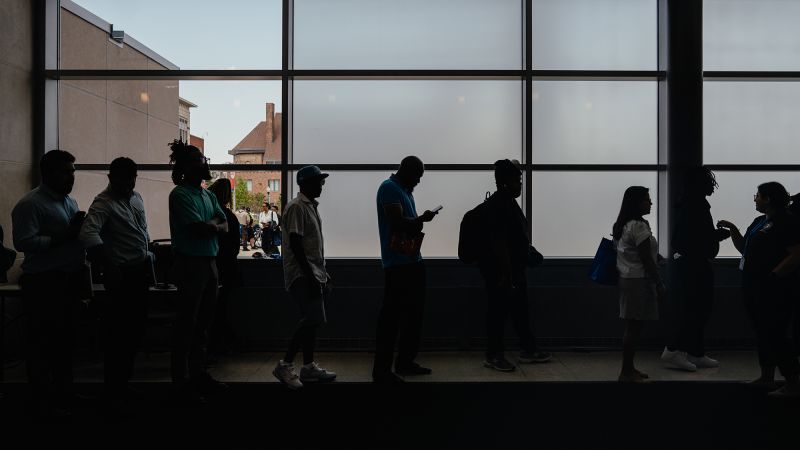US Job Market Shows Mixed Signals Amidst Economic Uncertainty
The US job market, a crucial barometer of economic health, continues to display resilience despite the prevailing economic uncertainty and the potential impact of President Trump’s trade policies. While the latest data reveals positive job growth, a closer examination reveals some concerning trends that warrant careful consideration.
A Strong Headline, But a Complex Reality
According to the Bureau of Labor Statistics, the economy added a solid 147,000 jobs in June, exceeding expectations of 117,500. This pushed the unemployment rate down to 4.1% from 4.2%, seemingly painting a picture of a healthy and thriving job market.
The previous months also saw upward revisions, with April’s and May’s figures adjusted to reflect a net gain of 158,000 and 144,000 jobs respectively. This brought the three-month average job growth to a respectable 150,000.
However, beneath the surface of these positive headline numbers, several concerning signs indicate potential vulnerabilities and unevenness in the job market’s performance.
Uneven Job Growth: A Cause for Concern
One of the most notable concerns is the lack of widespread job growth across various sectors. The majority of gains were concentrated in a few specific industries, namely healthcare (+58,600 jobs), leisure and hospitality (+20,000 jobs), and state and local government (+80,000 jobs).
The disproportionate contribution of these sectors raises questions about the overall health and diversification of the job market. Relying heavily on a few industries makes the economy vulnerable to sector-specific shocks and limits opportunities for workers in other fields.
The Public Sector Puzzle
The surge in state and local government jobs also deserves closer scrutiny. Some economists, like those at Pantheon Economics, suggest that this increase may be “artificial” due to seasonal adjustments.
Seasonal adjustments are mathematical techniques used to smooth out fluctuations in economic data caused by recurring seasonal events, such as weather patterns or holidays. These adjustments aim to provide a clearer picture of underlying trends by removing the effects of predictable seasonal variations.
In the case of education jobs, for instance, there is typically a decrease during the summer months. However, if the decrease is not as sharp as usual, the seasonal adjustment factor might interpret this as a strong gain. This can lead to an overestimation of job growth in that sector.
Private Sector Slowdown
When excluding the public sector gains, the picture becomes even less rosy. US private sector businesses added only 74,000 jobs in June, marking the smallest monthly gain since October 2024.
This slowdown in private sector job creation is a cause for concern, as it suggests that businesses may be hesitant to expand their workforce due to economic uncertainties.
The Impact of Trade Policies and Economic Uncertainty
Economists like Samuel Tombs at Pantheon Macroeconomics argue that the “tariff tax hike, restrictive monetary policy, and worries about a further intensification of the trade war are weighing heavily on labor demand.”
President Trump’s trade policies, particularly the imposition of tariffs on imported goods, have created uncertainty for businesses. Tariffs can increase the cost of imported raw materials and components, making it more expensive for businesses to produce goods. This can lead to reduced investment, hiring freezes, and even layoffs.
The potential for an escalating trade war further exacerbates these concerns. If countries retaliate with their own tariffs, it could disrupt global supply chains, reduce international trade, and negatively impact economic growth.
A Declining Labor Force and Rising Unemployment for Black Workers
The June jobs report also revealed other troubling trends, including a decline in the labor force participation rate and a surge in the unemployment rate for Black workers.
The labor force participation rate measures the percentage of the working-age population that is either employed or actively seeking employment. A decline in this rate suggests that people are dropping out of the labor force, potentially due to discouragement or lack of opportunities.
The unemployment rate for Black workers jumped by 0.8 percentage points to 6.8%, its highest rate since January 2022. This is particularly concerning because rising unemployment levels for Black workers have historically served as an indicator of broader economic weakness.
Wage Growth Stagnation
Workers’ wages overall increased at a slower pace than economists had anticipated. Average hourly earnings rose by 8 cents, or 0.2%, to $36.30 last month, bringing the annual rate to 3.7% from 3.9%.
Stagnant wage growth can have several negative consequences. It can reduce consumer spending, which is a major driver of economic growth. It can also lead to increased income inequality and social unrest.
Immigration Policies and Their Impact on the Labor Force
Some economists argue that tighter immigration policies may also be contributing to the decline in the labor force. As immigration becomes more restrictive, it can reduce the supply of workers, potentially leading to labor shortages in certain sectors.
This can put upward pressure on wages, but it can also make it more difficult for businesses to find qualified workers, hindering economic growth.
Layoff Activity Remains Muted, But Challenges Persist
Despite the economic uncertainties and potential headwinds, layoff activity has remained relatively muted. Stocks responded positively to the jobs report, with the Dow rising by 365 points, or 0.8%, by mid-morning. The broader S&P 500 rose 0.8%, and the tech-heavy Nasdaq gained 0.9%.
However, while employers are generally holding on to their workers, hiring activity remains low, and workers are not feeling confident enough to quit their jobs. This “low churn” environment can stifle innovation and limit opportunities for career advancement.
While first-time claims for unemployment insurance have not been steadily rising, people appear to be having a harder time finding work when they are unemployed. Continuing claims, which are filed by people who have received jobless benefits for at least one week, have been approaching three-and-a-half-year highs.
The jobs report also highlighted that job seekers are staying unemployed for roughly six months, and the share of unemployed workers who have been out of a job for 27 weeks or longer has been increasing.
Analysis and Conclusion: Navigating a Complex Economic Landscape
The US job market presents a mixed bag of signals. While headline numbers indicate continued growth, underlying trends reveal vulnerabilities and unevenness. The concentration of job gains in specific sectors, the slowdown in private sector hiring, the decline in labor force participation, and the rising unemployment rate for Black workers are all causes for concern.
President Trump’s trade policies and the resulting economic uncertainty are undoubtedly weighing on labor demand and investment decisions. While layoff activity remains muted, the low churn environment and the increasing duration of unemployment suggest that challenges persist.
Moving forward, policymakers need to carefully consider the impact of trade policies and economic uncertainty on the job market. Investing in workforce development programs, promoting entrepreneurship, and addressing income inequality are crucial steps to ensure a more inclusive and sustainable economic future.
The job market is a complex and dynamic entity, and its performance is influenced by a multitude of factors. A comprehensive and nuanced understanding of these factors is essential for making informed policy decisions that promote economic growth and opportunity for all Americans.





